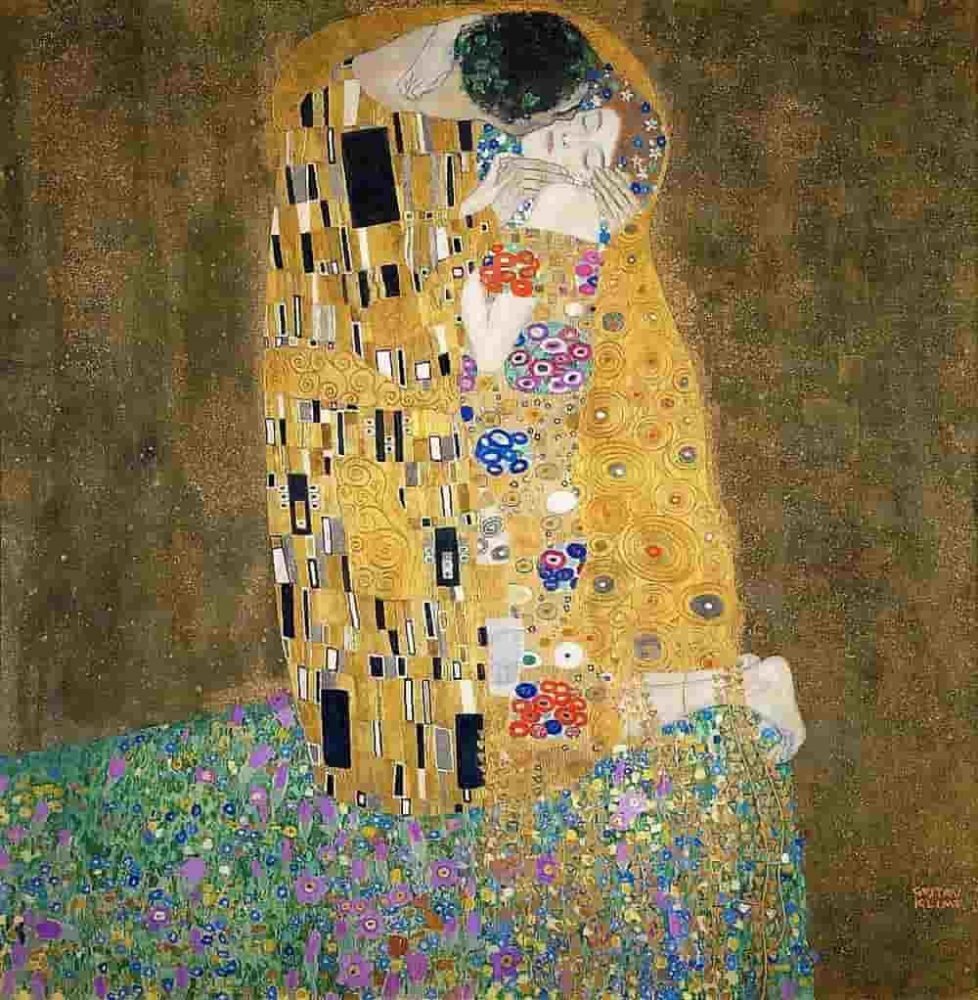The Kiss (Der Kuß) the secrets of a famous painting by Gustav Klimt
Created in 1906, The Kiss by Gustav Klimt is one of the most famous paintings by the Austrian symbolist painter. Between tenderness and passion, Artalistic returns today to this emblematic work kept at the Belvedere Palace in Vienna, a true masterpiece that has marked the history of art.
The Kiss, Gustav Klimt’s most famous painting
A whole life turned to art
When Gustav Klimt (1862-1918) painted The Kiss, he was plagued by doubt and loneliness. The artistic panic won over him despite an astonishing, successful and successful career. Very early on, the native of Baumgarten showed a taste for art. In 1876, he joined the School of Decorative Arts in Vienna at the age of 14, studied there for seven years before training as an architectural painter. In particular launched with his brother, his own workshop produced many frescoes commissioned by the public buildings of the city of Vienna.
From success to dissidence and consecration
From 1890, Klimt met with great success at the same time as he emerged artistically and ideologically from Viennese academicism. In 1897, he founded the secessionist group which aimed to transform art and break with the conservatism of the time.
His famous compositions Philosophy, Medicine and Jurisprudence painted on the ceiling of the University of Vienna are considered scandalous and even pornographic.
He decides to leave the Secession of which he is however the instigator and the eminent representative with Egon Schiele. Klimt continued to produce major works such as the Beethoven Frieze (1902) and Portrait of Adele Bloch-Bauer (1907). He experienced further substantial successes towards the end of his life. In 1910, he took part in the Venice Biennale and his painting La Vie et la Mort won an award in Rome on the occasion of the 1911 International Exhibition.
The Kiss: Gustav Klimt paints a picture of incredible richness
Richness and depth
It was therefore at a critical moment in his career that Gustav Klimt painted The Kiss, a painting included in the artist’s “golden cycle”. The Austrian genius has never hidden his appetite for ornamental work and gold leaf, a taste he inherited from his father, whose job it was.
Klimt’s The Kiss is thus a life-size canvas (180 x 180 cm) with a golden powder coating, a luminous frame that in no way hinders the shimmering colors, the dazzling beauty and the symbolic depth of the painting, quite the contrary.
Klimt’s Kiss or the ultimate symbol of eternal love
During its public presentation, the painting The Kiss by Gustav Klimt dazzles immediately. The Viennese government buys the work deemed to be of national interest. The painting depicts a couple kissing, wrapped in a sheet or golden coat. She wants to be revolutionary insofar as Klimt paints “what we should not see” usually: the brushing, the intertwining, the kisses, the eroticism, the embrace.

Details of the work
Wealth, Love, Eternity
The Kiss is an impressive work that overwhelms people who are lucky enough to contemplate it firsthand. Gustav Klimt uses here his inspiration for Japanese prints and a touch of neo-impressionism to sign an archetype of Art Nouveau.
The gold that is omnipresent on the painting Le Baiser symbolizes the wealth that gives a dimension of eternity to the couple that it encloses and protects. This sublime and gigantic work has been the subject of numerous analyses, of which here are some secrets.
The couple
The man and the woman present on the canvas are the only protagonists of Klimt’s painting. The Kiss delivers the two lovers to their desire which is expressed outside of time and space. The lovers would represent the artist and his longtime partner, fashion designer Emilie Flöge, unless the woman was one of Klimt’s many muses or conquests!
The importance of details
The man
The use of geometric patterns is one of Gustav Klimt’s signatures, not just on the painting The Kiss. The man’s train is drawn with hard lines and black or lighter rectangles as a metaphor for male power.
The woman
Voluptuous circles are symbols of femininity and motherhood. Softness and a feeling of abandonment emerge from the feminine features and the clothes adorned with blue, red and pink flowers. Note that the flexibility of lines and curves is typically distinctive of Art Nouveau.
A universal message, a hymn to love
While the vegetable bed, a carpet of flowers, demonstrates the importance of nature in Klimt’s eyes, the deep essence of The Kiss lies in the symbolic building of links between love, the spiritual and the divine, the latter dimension definitively encompassing the greatness of a unique work in the world. With a universal message as a conclusion unfolding in the form of a hymn to transcendental (emphasizing spiritual matters) love.
Sources: PinterPandai, Arts and Culture, Gustav Klimt



